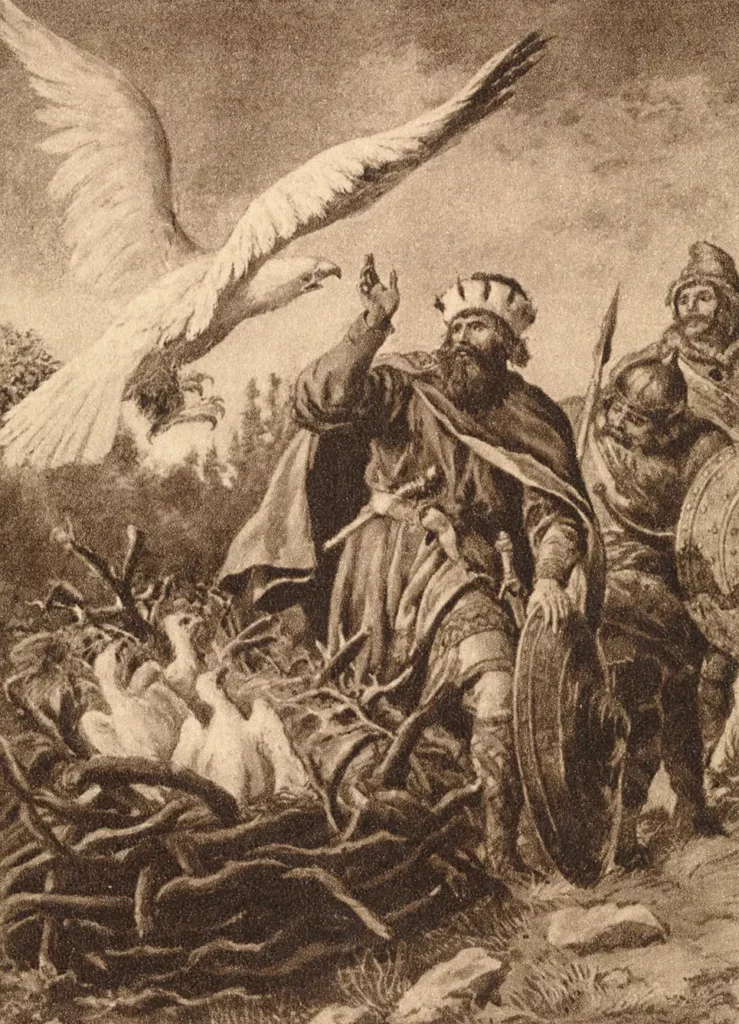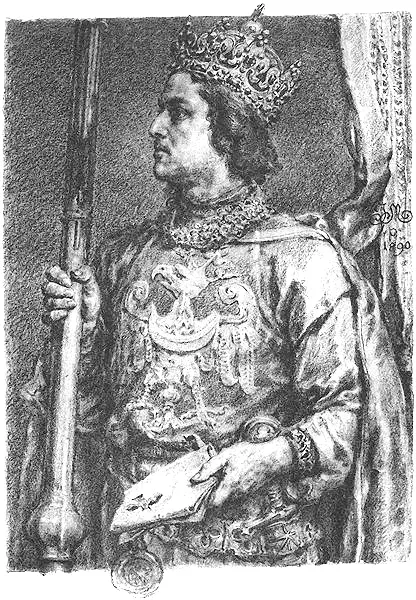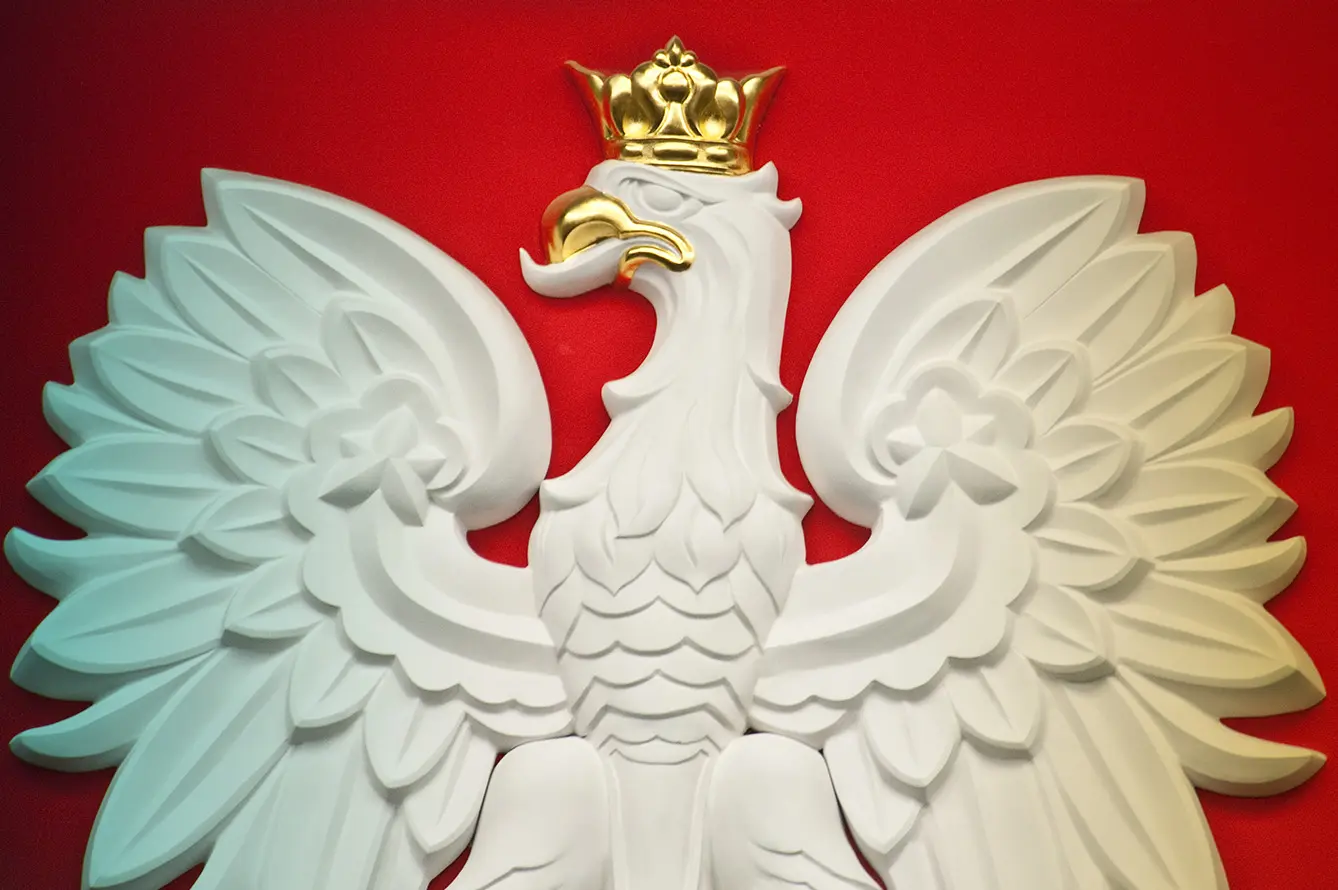According to the legend, Lech, the founder of Poland, was hunting with his two brothers: Rus (the founder of Ruthenia) and Czech (the founder of Slovakia… Nah! Got you! Czechia, of course.) Czech and Rus bid their farewells, and each went their own way – one east, the other one west. Lech, wanting to pick up an arrow, walked towards a tree. On it, he saw a white eagle, very protective of his younglings. It stood up high in the nest to warn the intruder.
The sun was setting, and the long sunbeams made the eagle shine as if its wings were made of gold. Behind the bird, the sky was tainted red. At that moment, Lech decided to settle where the eagle nested and founded a borough, which was to become Poland’s first capital – Gniezno (in a very loose translation: the nest).


Polish coat of arms: A pigeon, a peacock, or an eagle?
Since then, Lech was said to have used the symbol of the eagle as his own. And so the story of Poland’s coat of arms began. It is believed that the oldest official use of the eagle comes from the 11th century and can be seen on the coins minted by the first crowned ruler of the Polish lands – Bolesław Chrobry. Let’s leave aside the expert discussions on whether his coins depict an eagle, a peacock, or a cockerel and be content with the fact that it is, beyond a doubt, a bird of a feather. However, a white eagle in a crown was not yet a national emblem at that point.

I’ll show you my bird, and you will know who I am
At first, the variations of a white eagle presented against a red background were personal symbols of rulers of the Piast dynasty. However slightly different, they all resembled each other and can be found on headstones or some preserved stamps. Still, all those eagles were symbols of particular Piast princes. It changed in 1295 when Przemysław II became king and used his personal symbol – the now-crowned white eagle – as the coat of arms of the Kingdom of Poland.
From then on, the eagle was accepted by subsequent rulers and present on coins, official documents, royal insignia, etc. The eagle remained with Poles throughout the reign of the following Jagiellonian dynasty, the dynasty of Vasa, and was assigned to all kings elected by the nobles. During the time of partitions, different versions of the white eagle were chosen as symbols in subsequent uprisings. One thing can be said – the eagle has been uniting the nation through many hardships. Not the white and red flag, to make it clear. This came later.
White eagle, golden talons v. golden legs
After Poland regained independence in 1918, the leaders of the reinstated state chose a white and red flag and the white eagle as national symbols. The latter was specifically defined as a white, crowned eagle, presented against a red background, with golden legs and an open beak. Interestingly, the golden talons and crown shape have become a bone of discontent amongst heraldry experts and governments. Under the Soviet occupation, the eagle was deprived of the crown, yet it still served as a national symbol, unlike in some other occupied countries, where communist symbolism took over.

21. Reign of King Stanisław August Poniatowski (1764-1795); 22. Regimental banner (1807); 23. Duchy of Warsaw (1907-1815); 24. November Uprising (1831); 25. Kingdom of Poland (1842); 26. Polish Legion in Hungary (1848); 27. The period of the January Uprising (1863); 28. Republic of Poland (1919-1927); 29. Coat of arms of the Republic of Poland(1927-1945); 30. Emblem of the Polish People’s Republic (1944-1989). Photo: Andrzej Wiernicki / Forum
When the 1945-1990 regime fell, the eagle returned and regained its crown. However, its shape is not perfect, according to some. Experts claim that the crown should not be solid but with gaps and, ideally, should feature a cross on the top.
The issue also applies to the eagle’s legs, which are white, with only the talons sporting an exclusive golden manicure. The experts agree – the legs should be entirely of golden color. Recently, the Polish government introduced changes in the official template of the coat of arms; however, the relevant Act of parliament is still missing and is anticipated. The Act will more than likely reintroduce the Presidential Flag since Poland is the only country in Europe without one.
100,000 trees to prove the love
Today, Polish people, just as much as in the past centuries, love their white eagle. It is present on souvenirs, patriotic clothing, patriotic gadgets, such as bumper stickers, and literally – anything you can think of (yes, even seen patriotic underwear…). By golly, it is not uncommon to see it tattooed! And can you beat a world record with your national emblem?
Poles can! In 2018, after a hurricane destroyed large parts of Kashubian forests, the people of Lipusz decided to replant the woods in the shape of… the Polish coat of arms. To do so, they used 67k of pine trees, 23k of birch, and 400 specimens of larch, all planted over… six hours. It is situated on a frequently used air route so aircraft passengers can see and admire it. The process of its registration in the Guinness World Book of Records is at its last stage, and soon Poland will officially have the largest planted national emblem in the world.







